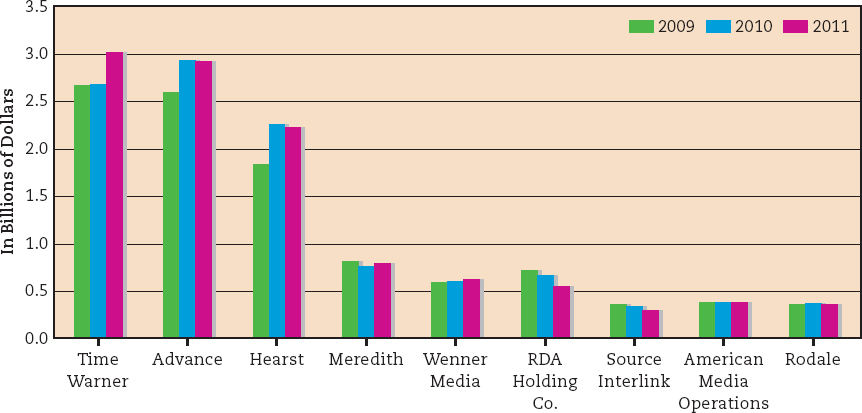Major Magazine Chains
In terms of ownership, the commercial magazine industry most closely resembles the cable television business, which patterned its specialized channels on the consumer magazine market. Also, as in the cable industry, large companies or chains increasingly dominate the magazine business (see Figure 9.1). Even though about seven hundred to one thousand new commercial magazine titles appear each year—many of them independently owned—it is a struggle to survive in the competitive magazine marketplace.

Note: Estimates provided by Advertising Age, Data Center, December 2012. Numbers represent revenues of the companies’ publishing divisions.
Source: Pew Research Center’s Project for Excellence in Journalism, State of the News Media 2013.
Time Warner’s magazine subsidiary, Time Inc., is the largest magazine chain (by circulation) in the United States, with twenty-one major titles, including Time, People, and InStyle. (See “What Time Warner Owns”.) Although the Time Inc. magazines generate 21.5 percent of U.S. consumer magazine revenue, the magazine division has produced the lowest growth of all divisions for parent company Time Warner in recent years. In 2013, the media conglomerate announced that it would be spinning off its magazine unit as a separate company by the end of the year. (It wasn’t the first time Time Warner reduced its holdings; it spun off both Time Warner Cable and AOL in 2009.)
Long a force in upscale consumer magazines, Condé Nast is a division of Advance Publications, which operates the Newhouse newspaper chain. The Condé Nast group controls several key magazines, including Vanity Fair, GQ, and Vogue. Advance Publications also owns Parade magazine, the popular Sunday newspaper supplement that goes to thirty-three million homes each week. (Since Parade comes with newspaper subscriptions, it is not counted among most official magazine tallies.)
Other important commercial players include Rodale, a family-owned company that publishes health and wellness titles like Prevention and Men’s Health, and the Meredith Corporation, which specializes in women’s and home-related magazines. The Hearst Corporation, the leading magazine (and newspaper) chain early in the twentieth century, still remains a formidable publisher with titles like Cosmopolitan, Esquire, Elle, and O: The Oprah Winfrey Magazine.
In addition, a number of American magazines have carved out market niches worldwide. Reader’s Digest, Cosmopolitan, National Geographic, and Time, for example, all produce international editions in several languages. In general, though, most American magazines are local, regional, or specialized and therefore less exportable than movies and television. Of the twenty thousand titles, only about two hundred magazines from the United States circulate routinely in the world market. Such magazines, however, like exported American TV shows and films, play a key role in determining the look of global culture.
Many major publishers, including Hearst, Meredith, Time, and Rodale, also generate additional revenue through custom publishing divisions, producing limited-distribution publications, sometimes called magalogs, which combine glossy magazine style with the sales pitch of retail catalogues. Magalogs are often used to market goods or services to customers or employees. For example, Rodale produces the biannual Whole Foods Market Magazine magalog, which launched in 2012, and Time produces the quarterly myFord, distributed by the automobile company to buyers of its vehicles and also available digitally via the iTunes App Store.
WHAT TIME WARNER OWNS
Consider how Time Warner connects to your life; then turn the page for the bigger picture.
BOOKS/MAGAZINES
- DC Entertainment
– DC Comics
– Mad magazine
- Time Inc.
– All You
– Coastal Living
– Cooking Light
– Entertainment Weekly
– ESSENCE
– FORTUNE
– GOLF
– Health
– InStyle
– Money
– People/People en Español
– People StyleWatch
– Real Simple
– Southern Living
– Sports Illustrated
– Sunset
– This Old House
– Time
- IPC Media (60+ U.K. magazines)
- Grupo Editorial Expansión (25 titles)
TELEVISION/CABLE
- HBO
– HBO
– Cinemax
- Turner Broadcasting System
– Cartoon Network
– CNN/CNN International
– HLN
– TBS
– TCM
– TNT
– truTV
- Warner Bros. Television Group
– The CW Network
– Telepictures Productions
– Warner Bros. Television
– Warner Bros. Animation
– Warner Home Video
– Warner Horizon Television
– Studio 2.0
MOVIES
- New Line Cinema
- Warner Bros. Pictures
- Warner Bros. Theatre Ventures
INTERNET
- 10best.com
- CNN.com/CNNMoney.com
- FanNation.com
- LIFE.com (with Getty Images)
- myrecipes.com
- PeoplePets.com
- MyHomeIdeas.com
- Turn page for more
WHAT DOES THIS MEAN?
Time Warner practices synergy: Its movies provide content for its cable channels, while its magazines can both promote and provide content for its cable and movie companies.
- 2012 Revenue. 28.7 billion.1 Time Warner is the third largest media company in the world.
- Magazine Leader. Time Inc. is the largest U.S. magazine publisher based on revenues, engaging over 138 million adults in print, online, and via mobile devices each month.2
- Magazine Advertising. Time Inc. earns 21.5 percent of all magazine advertising dollars.3
- Magazine Sales. More than one hundred Time Inc. titles are sold in the United States every minute.4
- Franchises. The Sports Illustrated annual swimsuit issue, which now includes videos, calendars, an iPhone app, and a Web site, is among the most profitable of any single magazine-branded franchise. The Harry Potter franchise has earned $7.6 billion to date.5
- Television. Warner Bros. Television Group produced more than 50 television series for the 2011-12 season, and then promoted these shows heavily throughout their magazine holdings, and has been the largest provider of primetime broadcast TV programming for 20 of the past 25 years.6
- Cable Power. HBO and Cinemax branded networks are available in over 60 countries throughout Latin America, Central Europe, Asia, and South Asia.7
- Movies. Time Warner has produced 6,650 feature films, 50,000 television titles, and 14,000 animated titles (including over 1,500 classic animated shorts).8
